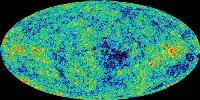(Clearwisdom.net)
On February 11, 2003, NASA released the best "baby picture" of the Universe ever taken, containing such stunning detail that it may be one of the most important scientific results of recent years. (AFP photo)
The new cosmic portrait -- capturing the afterglow of the Big Bang, called the cosmic microwave background -- was taken by scientists using NASA's Wilkinson Microwave Anisotropy Probe (WMAP) during a sweeping 12-month observation of the entire sky.
One of the biggest surprises revealed in the data is that the first generation of stars to shine in the Universe ignited only 200 million years after the Big Bang, much earlier than many scientists had expected.
In addition, the new portrait precisely pegs the age of the Universe at 13.7 billion years old.
Further, the study finds that early universe was 4 percent real matter in the form of atoms, about 23 percent unseen dark matter, and about 73 percent dark energy, a totally unknown and exotic force that causes the universe to accelerate at an ever-faster pace.
Importantly, all of these figures are in line with other estimates made from data collected in the nearby universe. Astronomers said the new results now serve as a cornerstone for modern cosmological theory and support its most widely accepted aspects.
Andrei Linde, of Stanford University, developed some of the inflationary models that still seem to be alive. He had been greatly anticipating the results and in a telephone interview called them "extremely impressive."
Linde said inflation had seemed like science fiction when it was first introduced, about 20 years ago.
"We didn't expect in our lifetimes it would be verified," Linde said. "Now we hear the basic features of inflationary cosmology fit with observational data."
References:
http://www.nasa.gov/HP_FLB_Feature_MAP_030211.html
http://www.space.com/scienceastronomy/map_discovery_030211.html






